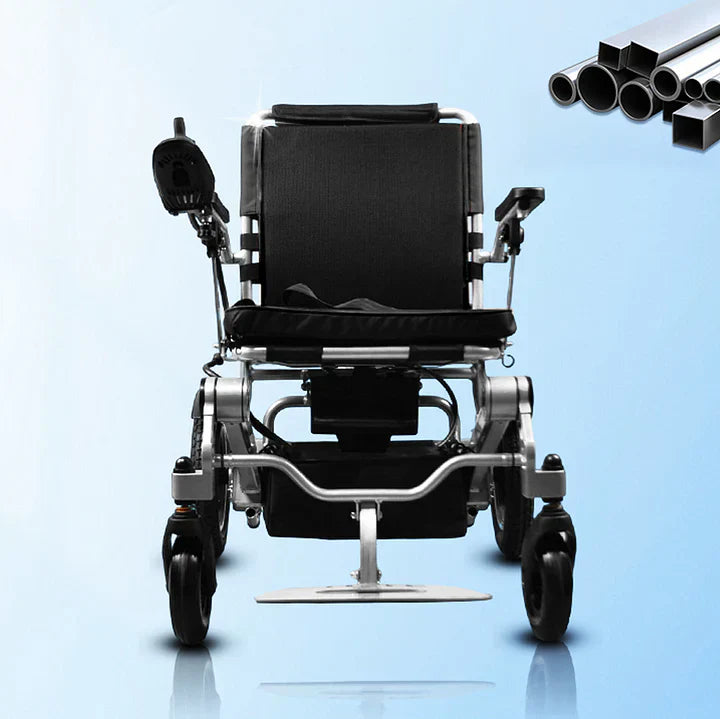
As the winter months approach, it’s essential to pay extra attention to the maintenance of your electric wheelchair. Cold temperatures, wet conditions, and harsh weather can take a toll on the performance and longevity of your mobility device. Proper care during this season can ensure your electric wheelchair continues to function smoothly and safely. In this blog, we’ll explore some key tips on how to maintain your electric wheelchair during the winter and keep it in top shape for the season ahead.
1. Check and Protect the Battery
One of the most important components to maintain during winter is the battery. Cold temperatures can significantly reduce battery life, as the chemical reactions that power the battery slow down in colder environments. Here’s how to take care of it:
- Keep it charged: Cold weather can cause the battery to drain faster than usual. It’s important to charge your electric wheelchair regularly, even if you’re not using it. Aim to keep the battery at about 50-80% charge during long periods of non-use.
- Store indoors: Avoid leaving your electric wheelchair outside or in a cold garage, as freezing temperatures can damage the battery. Store your wheelchair in a warm, dry place when not in use.
- Use a battery maintainer: If you don’t plan on using your wheelchair for an extended period, consider using a battery maintainer. These devices can help keep your battery at an optimal charge and protect it from freezing.
2. Inspect and Maintain the Tires
Winter can present unique challenges for electric wheelchair tires, especially when navigating snow, ice, and slush. To ensure your wheelchair’s tires perform well, here are some tips:
- Check tire pressure: Cold temperatures can cause tire pressure to drop, which can lead to less efficient movement and wear. Check the tire pressure regularly, and inflate the tires to the recommended level.
- Consider all-terrain tires: If you live in an area that experiences heavy snow or rough outdoor terrain, you might want to switch to all-terrain tires. These tires offer better traction and are more suited for winter conditions.
- Clean the tires regularly: Snow, salt, and debris can accumulate on your tires, affecting their performance. Clean them with a damp cloth or gentle cleaner to prevent buildup that could reduce traction.
3. Protect the Motor and Wiring
The motor and wiring of your electric wheelchair are sensitive to moisture and extreme cold. Taking steps to protect these components can prevent costly damage:
- Cover the motor: If your wheelchair is exposed to snow or rain, consider using a waterproof cover to shield the motor. This can protect it from moisture that could cause electrical malfunctions.
- Inspect wiring: Ensure that all wiring is intact and protected from the cold. Look for any frayed wires or loose connections, as these could be more susceptible to damage in freezing temperatures.
- Avoid puddles and salt: Salt from roads and walkways can corrode metal parts over time. After exposure to wet conditions, wipe down the wheelchair and motor to prevent corrosion.
4. Lubricate Moving Parts
Cold weather can cause the moving parts of your electric wheelchair, such as joints, axles, and wheels, to become stiff or harder to move. Regular lubrication will help keep your wheelchair in optimal working condition:
- Use appropriate lubricants: Use a silicone-based lubricant for moving parts like hinges, armrests, and footrests. Avoid petroleum-based lubricants, which can attract dirt and debris.
- Check for stiffness: If you notice any stiffness or difficulty in maneuvering, check the parts that require lubrication. Apply lubricant carefully to avoid excess buildup, which can attract dust.
5. Protect the Upholstery and Seat
The seat and upholstery of your electric wheelchair can be affected by winter conditions. Wet clothing, snow, or salt residue can cause fabric damage or mildew. Here’s how to protect it:
- Use waterproof covers: Consider using waterproof seat covers to shield your upholstery from wetness and salt damage.
- Clean and dry regularly: If your seat gets wet, clean and dry it as soon as possible. Mold and mildew can develop quickly in damp conditions, which could lead to unpleasant odors and fabric deterioration.
- Store in a dry place: Always store your electric wheelchair in a dry, heated area when not in use. This prevents moisture buildup and keeps the seat material intact.
6. Keep the Joystick and Controls Functioning
In winter, the joystick and control system of your electric wheelchair may be subject to freezing or moisture buildup, affecting performance. Follow these tips to ensure smooth operation:
- Protect the joystick: If the joystick or control pad is exposed to snow or rain, use a protective cover or wrap to keep it dry.
- Clean regularly: Clean the joystick and other controls regularly to remove dirt and salt. Use a damp cloth and avoid harsh cleaning agents, as they can damage the electronic components.
- Check responsiveness: Test the joystick and other controls frequently to ensure they are responding correctly, especially after exposure to moisture.
7. Regularly Check for Wear and Tear
Winter conditions can accelerate wear and tear on your electric wheelchair, especially when navigating rough, slippery surfaces. Regularly inspect your wheelchair for any signs of damage:
- Inspect the frame: Check for any cracks, rust, or signs of damage on the frame of the wheelchair. Salt and moisture can corrode metal parts over time.
- Test the brakes: Cold temperatures can affect the brakes, so ensure they are working properly. Test them regularly to avoid accidents or falls.
- Check for rust: Look for any signs of rust on metal components and treat them promptly with rust-resistant coatings.
8. Be Mindful of the Weather Conditions
While not directly related to maintenance, it’s important to consider weather conditions when using your electric wheelchair in winter. If possible, avoid using your wheelchair in extreme cold or during snowstorms. Wet, icy surfaces can be slippery, making it more difficult to maneuver. Additionally, battery life may be reduced in extremely cold temperatures, so plan your trips accordingly to avoid running out of power unexpectedly.
Conclusion
Winter weather can be harsh on your electric wheelchair, but with the proper care and maintenance, you can ensure that it continues to function reliably throughout the season. By protecting the battery, maintaining the tires, and keeping the motor and upholstery in top condition, you’ll be able to enjoy smooth, safe, and comfortable mobility, no matter the weather.
Remember to regularly inspect and maintain your electric wheelchair to avoid costly repairs and ensure maximum performance. With these winter care tips, you can continue to enjoy the freedom and independence your electric wheelchair provides, all year round.





Leave a comment
This site is protected by hCaptcha and the hCaptcha Privacy Policy and Terms of Service apply.